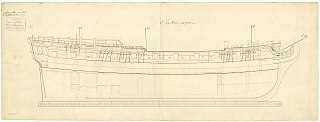Royal Admiral was the name of one vessel that served the East India Company (EIC), and one vessel that was going to serve the EIC, but that the Royal Navy purchased before she launched.

The East India Company (EIC), also known as the Honourable East India Company (HEIC) or the British East India Company and informally as John Company, Company Bahadur, or simply The Company, was an English and later British joint-stock company. It was formed to trade in the Indian Ocean region, initially with Mughal India and the East Indies, and later with Qing China. The company ended up seizing control over large parts of the Indian subcontinent, colonised parts of Southeast Asia, and colonised Hong Kong after a war with Qing China.

The Royal Navy (RN) is the United Kingdom's naval warfare force. Although warships were used by the English kings from the early medieval period, the first major maritime engagements were fought in the Hundred Years War against the Kingdom of France. The modern Royal Navy traces its origins to the early 16th century; the oldest of the UK's armed services, it is known as the Senior Service.
- Royal Admiral (1777 ship), of 498 tons (bm), made eight voyages for the EIC between 1778 and 1798 before she was sold. She then made a voyage for her new owners transporting convicts to Port Jackson. She made a return trip to England from China under contract to the EIC, and continued trading until c. 1807.
- Royal Admiral was on the stocks at Deptford when the Navy Board purchased her in 1796. The Navy renamed her HMS York and she served until 1804 when she was wrecked with the loss of all hands.
Royal Admiral was an East Indiaman, launched in 1777 on the River Thames. She made eight trips for the East India Company (EIC) before she was sold. She then continued to trade. She made two trips carrying convicts from England to Australia, one as an East Indiaman in 1791, and a second in 1800. On this second voyage as a convict transport she was present at a notable naval action.
Builder's Old Measurement is the method used in England from approximately 1650 to 1849 for calculating the cargo capacity of a ship. It is a volumetric measurement of cubic capacity. It estimated the tonnage of a ship based on length and maximum beam. It is expressed in "tons burden", and abbreviated "tons bm".
A convict is "a person found guilty of a crime and sentenced by a court" or "a person serving a sentence in prison". Convicts are often also known as "prisoners" or "inmates" or by the slang term "con", while a common label for former convicts, especially those recently released from prison, is "ex-con" ("ex-convict"). Persons convicted and sentenced to non-custodial sentences tend not to be described as "convicts".
| This article includes a list of ships with the same or similar names. If an internal link for a specific ship led you here, you may wish to change the link to point directly to the intended ship article, if one exists. |





